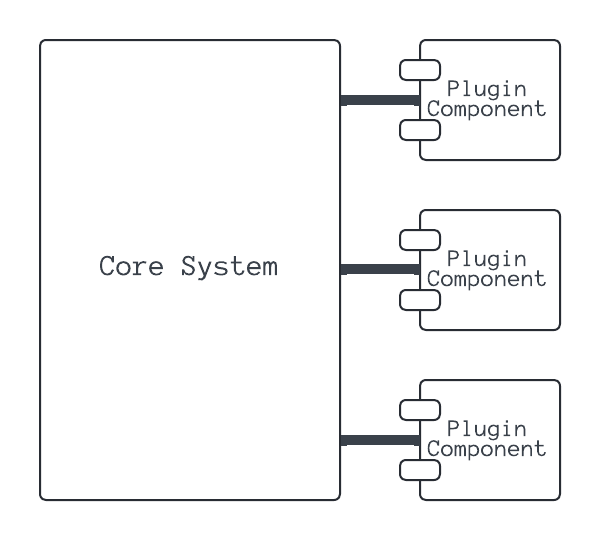Description
The microkernel architecture pattern is a way to structure an application as a set of loosely coupled, collaborating components. Each component has a specific responsibility or function, and each communicates with other components through well-defined interfaces. This pattern is used to build systems that can be easily extended, modified, and tested.
It is commonly used in systems that need to support a wide range of features or configurations. Some examples include:
- Operating Systems
- Web Servers
- Your favorite IDE
- Ruby
- Web Browsers
- Office Suites
- Terminal Emulators
How it works
The microkernel pattern is based on the idea of separating core functionality from additional features. The core functionality is implemented in a small, lightweight kernel, while additional features are implemented as plugins or modules that can be added or removed as needed.
Here’s a simple example of how this might work in a Go application:
- Let’s define a simple plugin interface:
type Plugin interface {
Start()
Stop()
}
- We can then define a kernel struct that will manage the plugins:
type Kernel struct {
plugins []Plugin
}
- We can then add methods to the kernel to add and remove plugins:
func (k *Kernel) AddPlugin(p Plugin) {
k.plugins = append(k.plugins, p)
}
func (k *Kernel) Start() {
for _, p := range k.plugins {
p.Start()
}
}
func (k *Kernel) Stop() {
for _, p := range k.plugins {
p.Stop()
}
}
- Finally, we can define a simple plugin that logs to a file:
type Logger struct {
logFile *os.File
}
func (l *Logger) Start() {
var err error
l.logFile, err = os.Create("log.txt")
if err != nil {
log.Fatal(err)
}
}
func (l *Logger) Stop() {
l.logFile.Close()
}
- We can then create a kernel, add the logger plugin, and start the kernel:
func main() {
k := &Kernel{}
logger := &Logger{}
k.AddPlugin(logger)
k.Start()
// Do some work
k.Stop()
}
Diagram

Pros
- Focus on core functionality and delegate other tasks to plugins
- Plugins can be developed, tested, and released in isolation
- Creates a modular and flexible architecture
- Loosely coupled components
- Can create entire ecosystems around the core functionality
- Clearly defined interfaces between components
Cons
- Backward compatibility can be challenging if there’s a desire to change the core functionality
- Can be difficult to manage dependencies between components
- If security is a concern plugins can introduce vulnerabilities if untethered
- If not managed properly, the core can become bloated with features
When to Use
I’d recommend using the microkernel architecture in some of the following scenarios:
- You need to support a wide range of features or configurations
- You want to create a modular and flexible architecture
- You want to create an ecosystem around the core functionality
- You want to delegate non-core functionality to plugins